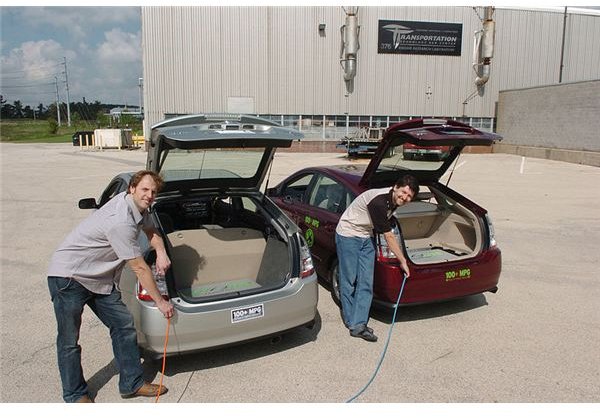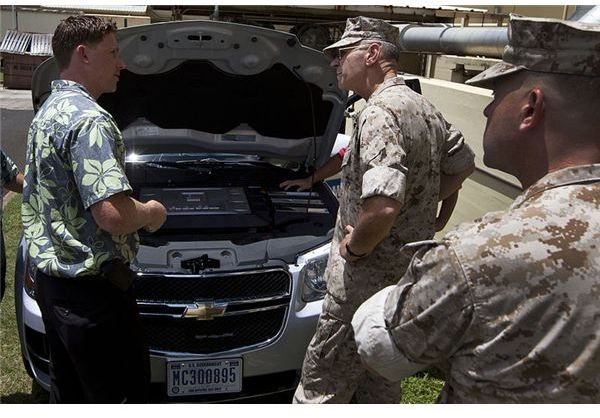A Guide to Green Cars: Hybrids, Plug-ins, Hydrogen Fuel Cell Electric Vehicles and More
For the entire 20th century, oil was king. The idea of an automobile running on anything other than gasoline was folly. Finally social, business and government forces are combining to encourage the production of vehicles fueled by alternative sources.
Pick your reason to drive something new. Eliminating greenhouse gasses? Saving money? Reducing dependence on foreign oil? Just a big fan of new ideas?
Hybrid Electric Vehicle (HEV)
A hybrid combines an electric motor and battery with a gas engine. The electric segment runs simultaneously or sometimes instead of the gas part. You cannot plug in and recharge the battery. Instead, it gains energy from regenerative braking.
Regenerative braking takes kinetic energy and converts it to electricity. In a traditional brake, the energy is converted to heat and wasted. This process can only occur on the drive wheels, so two-wheel drive vehicles can only regenerate power from the front or rear. The car cannot operate solely with regenerative brakes. At low speed or in emergencies, traditional brakes are necessary to stop the car.
The gas motor can also be used to spin an electric generator to charge the battery.
Hybridization improves the fuel economy of vehicles often at the cost of performance. Hybrid vehicles are typically tuned for efficiency, not power, and an emphasis is placed on lightweight materials.
As of October 2014, 9 million hybrids had been sold worldwide. Seven million carry the Toyota or Lexus brand, with over half of them Priuses. The Prius achieves over 50 miles per gallon and has become the wedge-shaped symbol of change.
Plug-In Hybrid Electric Vehicle (PHEV)

A PHEV is similar to an HEV except it is plugged into a charger to replenish its batteries. The charging port could be a 120- or 240-volt home unit or a public quick charger. A PHEV can operate for a short distance on electric power only. Typical range is 10-30 miles, depending on your driving style.
PHEVs often have multiple drive settings. The driver can choose to use only electric power, reserve battery power for later and burn gas instead, or use a combination. A survey by the Union of Concerned Scientists revealed that about half of Americans drive less than 40 miles a day. With charging facilities available where they work, study or shop and a PHEV with a 20-mile range, those drivers would burn almost no gas at all.
Actual mileage depends on the driver. Those who start and stop fast will use up the battery charge faster. When accelerating hard, some PHEVs will engage the gas engine to augment performance. So lead-foots may burn gasoline speeding away from the charging station.
Some plug-ins employ a range-extender engine that is never intended to power the wheels. It is designed only to charge the battery and will engage when the charge is low. This gives electric car cleanliness with gasoline range.
The Chevy Volt is a range-extended plug-in hybrid that uses a 1.4-liter 4-cylinder engine to charge a lithium-ion battery pack. The original version could travel 35 miles before using the range-extender or plugging in. The newest model, using a denser battery and lighter components, has a range of 50 miles.
Battery Electric Vehicles (BEV)
BEVs contain no gas motor at all. It carries a large battery pack and one to four electric motors. Some use one motor to power front or rear wheels. The sportiest models have an independent motor for each wheel, achieving all-wheel drive and improved cornering.
All-electric cars have only one gear and have consistent power across the RPM range. Therefore, torque and horsepower are instantly available from zero up to the redline. While gas engines have a sweet spot around 3000-5000 RPMs where power is the strongest, electric engines deliver their punch right from the start.
Most of the BEVs on the market are compact with two to four seats. Some are tuned for sparky performance and can reach 60 miles per hour in eight seconds or less, but many are built with conservative efficiency in mind. Their range is around eighty miles. When the battery runs out, the car is dead on the side of the road. Eighty miles is sufficient for ordinary commuting, but makes the vehicle unsuitable for long trips until the electric charging infrastructure improves. BEVs typically take several hours to charge from a 120 volt plug and half that from a 240. Public quick charging stations can accomplish this in twenty to thirty minutes.
Tesla is a pioneer in electric cars and produces vehicles that are anything but short-ranged and underpowered. Their debut Roadster was built on a Lotus Elise frame. The topless two-seater could go 0-60 in 3.7 seconds and had a range of 240 miles in 2009. Doubters of the electric car were left with their mouths agape. Tesla has since released the Model S sedan, to be followed by the Model X SUV and Model 3 compact car.
Hydrogen Fuel Cell Electric Vehicle (FCEV)

FCEVs are essentially electric cars, but rather than storing energy in a battery, they operate with a tank of hydrogen gas. The hydrogen is combined with oxygen to produce electricity. The only by-product is water. FCEVs can refuel in a few minutes like a gas car and travel hundreds of miles on one tank.
For now, the hydrogen refueling process is far behind. Filling stations exist in very few places, primarily in California, and while hydrogen is clean fuel, it is not clean to produce. It is not an efficient process. An electric current passes through water, separating the molecules. Grid electricity is commonly created by dirty methods and lots of fossil fuel is often burned to produce hydrogen. Clean solar hydrogen production is possible, but not yet common. Then there is the storage of flammable gas that must be considered. It’s much more volatile than gasoline. Just ask the Hindenburg.
The Toyota Mirai is the first hydrogen fuel cell car offered in the United States. It has a range of 300 miles and can reach sixty miles per hour in nine seconds. It drives much like an un-sporty BEV. Sales are limited to California areas close to charging stations.
So Which is the Best?
To answer than, analyze your driving habits. Can you complete your daily commute within the range of a PHEV or BEV? If you don’t have access to charging facilities, maybe an HEV is best. Automakers are making it easy to install a charger in your home. You may receive a tax credit for the charger and the car.
Where you live matters, too. Electric charging facilities are more common in the Northeast and West Coast. California is the champion of alternative fuels and the best place to find hydrogen.
New green cars are not cheap, but they often come with state and federal incentives. Study what you spend in fuel, maintenance, licensing and other costs. Compare that to something new and you might save money and the atmosphere.
Keep your eyes open. This market is changing rapidly. Ranges are growing, performance is improving, prices are lowering and inventors are designing new things all the time.
References
- Drive Clean: Hydrogen Fuel Cell
- Plugin Cars: Detailed List of Electric Cars and Plug-in Hybrids
- U.S. Dept. of Energy: Alternative Fuels Data Center
- Union of Concerned Scientist: Comparing Electric Vehicles: Hybrid vs. BEV vs. PHEV vs. FCEV
- Union of Concerned Scientists: Infographic - Electric Vehicles
